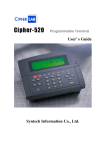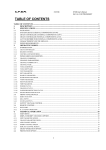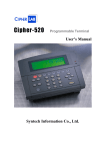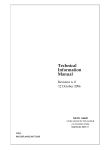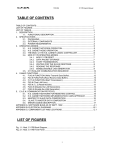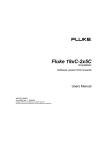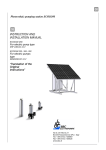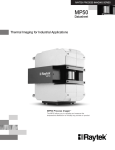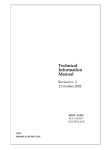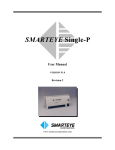Download CAEN V288
Transcript
Technical
Information
Manual
Revision n. 0
22 December 1992
MOD. V288
H.S. CAENET
VME CONTROLLER
CAEN will repair or replace any product within the guarantee period if the Guarantor
declares that the product is defective due to workmanship or materials and has not been
caused by mishandling, negligence on behalf of the User, accident or any abnormal
conditions or operations.
CAEN declines all responsibility for damages or
injuries caused by an improper use of the Modules
due to negligence on behalf of the User. It is strongly
recommended to read thoroughly the CAEN User's
Manual before any kind of operation.
CAEN reserves the right to change partially or entirely the contents of this Manual at any time and without
giving any notice.
TABLE OF CONTENTS
TABLE OF CONTENTS ...................................................................................................... i
1. DESCRIPTION............................................................................................................... 1
1.1.FUNCTIONAL DESCRIPTION........................................................................... 1
2. SPECIFICATION............................................................................................................ 3
2.1. PACKAGING ................................................................................................... 3
2.2. EXTERNAL COMPONENTS ............................................................................ 3
2.3. INTERNAL COMPONENTS.............................................................................. 3
2.4.POWER REQUIREMENTS ............................................................................... 3
3. OPERATING MODES..................................................................................................... 5
3.1. H.S. CAENET NETWORK OPERATION ........................................................... 5
3.2. H.S. CAENET NODE OPERATION................................................................... 6
3.3. THE MOD. V288 H.S. CAENET VME CONTROLLER........................................ 6
3.4. MOD V288 OPERATING MODES..................................................................... 7
3.4.1. RESET............................................................................................. 7
3.4.2. STATUS REGISTER......................................................................... 7
3.4.3. DATA PACKET STORAGE................................................................ 7
3.4.4. START TRANSMISSION................................................................... 8
3.4.5. WAITING FOR THE SLAVE RESPONSE ........................................... 8
3.4.6. READING THE RESPONSE.............................................................. 9
3.5. V288 - SLAVE COMMUNICATION SEQUENCE ................................................ 10
4. VME INTERFACE........................................................................................................... 11
4.1. V288 ADDRESSING CAPABILITY .................................................................... 11
4.2. V288 DATA TRANSFER CAPABILITY .............................................................. 11
4.3. TRANSMIT DATA BUFFER.............................................................................. 12
4.4. RECEIVE DATA BUFFER................................................................................ 12
4.5. STATUS REGISTER........................................................................................ 12
4.6. TRANSMISSION REGISTER............................................................................ 13
4.7. RESET REGISTER.......................................................................................... 13
4.8. INTERRUPT VECTOR REGISTER................................................................... 13
4.9. V288 INTERRUPTER CAPABILITY .................................................................. 13
4.10. V288 INTERRUPT LEVEL.............................................................................. 13
5. C.A.E.N. PROTOCOL ..................................................................................................... 15
5.1. H.S. CAENET NETWORK FOR REMOTING CONTROL. ................................... 15
5.2. H.S. CAENET NETWORK IMPLEMENTATION: CAEN APPROACH................... 15
5.3. MASTER TO SLAVE DATA COMPOSITION ..................................................... 17
5.4. SLAVE TO MASTER DATA COMPOSITION ..................................................... 17
5.5. ERROR CODES .............................................................................................. 18
6. REFERENCES............................................................................................................... 19
APPENDIX A SOFTWARE BUGS AS OF SEPTEMBER 1992 .............................................. A.1
A.1. H.S. CAENET OPERATION BUGS................................................................... A.1
APPENDIX B SOFTWARE EXAMPLES............................................................................... B.1
i
18/12/92
V288 User Manual
1. DESCRIPTION
1.1.FUNCTIONAL DESCRIPTION
The Model V288 HIGH SPEED (H.S.)CAENET VME CONTROLLER has been designed to
control an H.S. CAENET network through the VME bus. It houses an H.S. CAENET Node
and a Control Logic (microprocessor based) which integrates the functions of Node
controller and Network error handler.
Standard VME cycles allow the user to easily control the serial communication on the H.S.
CAENET network according to the typical MASTER/SLAVE communication protocol, where
the VME controller assumes the MASTER function.
It is composed of a collection of registers, for the operation control, and two memory buffers
for the data packet transmitted and received, arranged in a FIFO logic 16 bit wide 256 word
deep.
In the memory buffer for the received data are also stored error messages generated by the
on-board Control logic when the H.S. CAENET operation has failed
The Module is an A24 D16 VME Slave; Its Base Address is programmable through dip
switches located on the Board.
The module operations can be software controlled in polling mode or can be handled via
interrupt facility. It houses a VME ROAK INTERRUPTER [1] that generates a VME interrupt
(if enabled) as soon as the data packet (or the error message) is stored in the receive buffer.
The communication line uses a simple 50 ohm coaxial cable as physical medium.
The data transfer rate is 1 MBaud.
(A functional block diagram is shown in Fig. 1.1.)
1
18/12/92
V288 User Manual
H.S. CAENET
NODE
DB<0..15>
MUX
LOGIC
TX
FIFO
IB<0..7>
Serial data
I/O
50 ž
coaxial cable
CAENET
SERIAL
INTERFACE
VME
INTERFACE
RX
FIFO
RESET
REGISTER
TRANSMIT
REGISTER
DB0
STATUS
REGISTER
DB<0..7>
INTERRUPT
VECTOR REG.
IRQ<1..7>
CLOCK (3 MHz)
CONTROL
LOGIC
Man. RESET
H.S. CAENET INTERRUPT
INTERRUPTER
SW3..4
Fig 1.1 Mod. V288 block diagram
2
18/12/92
V288 User Manual
2. SPECIFICATION
2.1. PACKAGING
1-unit wide VME module.
2.2. EXTERNAL COMPONENTS
(refer to Fig. 2.1).
CONNECTORS
- No. 1
"SERIAL LINE" LEMO 00 type, 50 Ohm connector;
connector for the H.S. CAENET communication line.
LEDs
- No.1 "DATA",red LED;
is On when the H.S. CAENET Node is active.
SWITCHES
- No.1 "RESET"push button;
by pushing this button the V288 enters in restart mode; this causes the
following operations:
- the buffers are cleared;
- every VME interrupt pending is cleared;
- every data transfer is aborted;
- the V288 does not accept any command.
It remains in this status for about 3 msec.
2.3. INTERNAL COMPONENTS
SWITCHES
- No.3 dip-switches SW2,SW5,SW6;
These dip-switches allow the selection of the VME Base address.
- No.2 dip-switches SW3,SW4;
These dip-switches allow the selection of the VME interrupt level.
2.4.POWER REQUIREMENTS
+ 5V
2A
3
18/12/92
V288 User Manual
RESET Push Button
RESET
SERIAL
LINE
H.S. CAENET
Active LED
DATA
Fig 2.1 Mod. V288 Front Panel
4
H.S. CAENET
Connector
18/12/92
V288 User Manual
3. OPERATING MODES
3.1. H.S. CAENET NETWORK OPERATION
H.S. CAENET Network is a send and receive half duplex system; It permits asynchronous
serial transmission of data packet along simple 50 ohm coaxial cable. Several devices (H.S.
CAENET Nodes) are able to share the same media to transmit and receive data.
Each Node is able to receive the serial data packet and store it automatically in the RX FIFO
and to transmit the data contained in the TX FIFO. Both FIFOs are 512 byte deep.
The H.S. CAENET Node listen for clear coax before transmitting but it is not able to detect
collisions on the cable; for this reason it is important to avoid line contention i.e. the Nodes
should not attempt to transmit at the same time.
Usually transfers between H.S. CAENET Nodes take place according to the typical
MASTER/SLAVES communication: there is a single H.S. CAENET MASTER that initiates
the transmission, all the SLAVEs receive the data, and only the SLAVE addressed then
accesses the serial line to transmit the data requested by the MASTER.
The maximum data packet length is 512 bytes.
An external clock source provides the basic time reference in the Node: the clock frequency
is three times the data transfer rate. Actually the clock frequency used in the H.S. CAENET
network is 3 MHz (1 MBaud transfer rate);
The Node is seen as an 8 bit pheripheral device composed of a collection of registers and
two memory buffers arranged in FIFO logic. It generates an interrupt (H.S. CAENET
interrupt) upon:
- the completion of a transmission of a data packet
- the reception of a data packet
- when the RX FIFO has been completely unloaded.
5
18/12/92
V288 User Manual
3.2. H.S. CAENET NODE OPERATION
The basic operation of the H.S. CAENET Node consists in 3 distinct modes:
Transmit, Receive and Restart mode.
- In the Transmit mode the Node accesses the data stored in the TX FIFO and
transmits them on the cable.
- In the Receive mode the serial packet is stored in the RX FIFO.
- In Restart mode the Node does not execute any commands, all the TX and RX
buffers are cleared and the H.S. CAENET interrupt is removed; it remains in this
mode until it detects that the line is clear.
3.3. THE MOD. V288 H.S. CAENET VME CONTROLLER
The Model V288 H.S. CAENET VME CONTROLLER has been designed to easily control an
H.S. CAENET network through the VME bus. It houses an H.S. CAENET Node and a
Control logic (microprocessor based with dedicated firmware) which integrates the functions
of Node controller with Network error reporting and H.S. CAENET interrupt handler.
The Control logic directly controls the on-board H.S.CAENET Node and its multiplexing logic
interfaces the 16 bit VME data bus with the two 8 bit FIFOs so as they are seen by VME as
16 bit buffers. It receives commands from a VME Master in a way that few standard VME
cycles allow the user to easily control the serial communication on the H.S. CAENET
network; the communication is performed according to the typical MASTER/SLAVE
communication protocol, where the VME Master assumes the H.S. CAENET MASTER
function.
The Module is an A24 D16 VME Slave, it is composed of a collection of registers, for the
operation control, and two memory buffer for the data packets transmitted and received,
arranged in a FIFO logic 16 bit wide 256 word deep (see Fig.1.1)
The Status Register content indicates whether the previous H.S. CAENET Operation has
been successfully performed; in particular shows when the valid data are read from the
Receive Data Buffer.
In the memory buffer for the received data are also stored error messages generated by the
Control logic when the H.S. CAENET operation has failed.
The module operations can be software controlled in polling mode or can be handled via
interrupt facility. It houses a VME ROAK INTERRUPTER [1] that generates a VME interrupt
(if enabled) as soon as the data packet (or the error message) is stored in the receive buffer.
The interrupt vector is software programmable while the interrupt level is selectable via dip
switches;
The Mod. V288 registers are described in the Table 4.1.
6
18/12/92
V288 User Manual
3.4. MOD V288 OPERATING MODES
The following paragraphs describe the various operations that can be performed via VME
and the use of the V288 registers to accomplish an H.S. CAENET communication.
3.4.1. RESET
It is possible to reset the Mod V288 in these ways :
- by pushing the Front Panel push-button "RESET";
- by writing via VME at the address: Base + 6 (Reset Register).
After one of these operation the V288 enters in Restart Mode; this causes the following
operation:
- the buffers are cleared;
- every VME interrupt pending is cleared;
- every data transfer is aborted;
- the V288 does not accept any command.
It remains in this status for about 3 msec.
3.4.2. STATUS REGISTER
The LSB of the V288 Status Register indicates if the previous H.S. CAENET Operation
handled via VME is valid or not. The RESET operation (see above) is not considered as a H.
S. CAENET operation, thus the content of the Status Register is not valid after a RESET.
Status Register bit 0= 1
"No valid operation";
Status Register bit 0= 0
"Valid operation".
The Status Register is available at the VME address Base + 2.
3.4.3. DATA PACKET STORAGE
The data to be transmitted are stored in the TX FIFO by performing subsequent VME write
accesses to the address Base + 0 (Transmit Data Buffer); The buffer is arranged in FIFO
logic 16 bit wide.
After any writing operation the user is recommended to read the content of the Status
Register. A "No valid operation" means that the Transmit Data Buffer is not available for data
storage. This may occur in these cases:
- if the H.S. CAENET Node is active (it is transmitting a previous data packet or it is
receiving the SLAVE response data packet);
- if the Transmit Data Buffer is full (the maximum number of 16 bit data stored is 256).
7
18/12/92
V288 User Manual
3.4.4. START TRANSMISSION
An access in writing to the VME address Base + 4 (Transmission Register) enables the
Control logic to transmit on the cable the data packet stored in the Transmit Data Buffer.
The logic first check if the Buffer is empty,
- if not, the logic sets the H.S.CAENET Node in the Transmit mode and the data
packet is transmitted on the cable.
- If the Buffer is empty the control logic does not activate the transmission and write an
error code in the Receive data buffer (error %FFFD see Tab. 5.3).
The content of the Status register indicates if the Start Transmission command has been
recognized by the Control logic; a "No valid operation" means that the H.S CAENET Node is
not able to transmit data. This may happen if the H.S. CAENET Node is active (it is
transmitting a previous data packet or it is receiving the SLAVE response).
If a "valid operation" is contained in the Status register the user will receive the SLAVE
Response or a Control logic message within a maximum period of 500 msec (SLAVE
Response Time-out).
The Response is available at the address Base + 0 (Receive Data Buffer).
3.4.5. WAITING FOR THE SLAVE RESPONSE
The Control logic waits for the SLAVE Response for about 500 msec; if no data packet is
received within this period the Control logic stores an error code in the Receive Data Buffer
(error %FFFF see table 5.3).
If a data packet is received from the cable within the SLAVE Response Time-out, the Control
logic checks if it has the correct header: if not, clears the Receive Data Buffer and stores in it
an error code (error % FFFE see table 5.3).
After these operation, the Receive Data Buffer contains valid data (an error code or the
SLAVE response) for the VME Master that has initiated the H.S. CAENET communication.
At this point the Control logic enables the VME reading, and if the interrupt level selected on
the dip switches is different from 0, a VME Interrupt on the corresponding IRQ line [1] is
generated.
8
18/12/92
V288 User Manual
3.4.6. READING THE RESPONSE
The User after the transmission of the data packet expects a response in the Receive Data
Buffer; the presence of valid data can be recognized in two different ways: In polling mode or
by the use of the VME interrupt.
Polling mode:
- After the Start Transmission operation, the user reads the content of the Receive
Data Buffer (address Base + 0) and successively the Status Register (address Base
+ 2), this two read operations must be repeated until a "Valid Operation" is contained
in the Status Register; this means that the data read is the first data of the Response.
VME interrupt
- The generation of the VME interrupt means that valid data are present in the Receive
Data Buffer
Then the reading of the Receive Data buffer and the Status Register must be repeated until
a "No valid operation" is obtained.
9
18/12/92
V288 User Manual
3.5. V288 - SLAVE COMMUNICATION SEQUENCE
The operations previously described are summarized in the following report:
- write the data packet in the Transmit Data Buffer; in the packet is contained the H.S.
CAENET address of the SLAVE (see Tab 5.1 for the data structure).
for each data:
- write the data in the Transmit Data Buffer
- read the Status Register :
- if Status Register ="Valid operation"
{
the data is stored in the buffer.
}
- else
{
error.
}
- Transmit the data packet:
- Access in write the Transmission Register
- read the Status Register
- if Status Register = "Valid Operation"
{
the V288 H.S. CAENET Node enters in the transmit mode and the data
packet stored is transmitted on the cable.
}
- else
{
error.
}
- Wait for the SLAVE response
- if the Interrupt is enabled
{
wait for V288 interrupt
}
- else
{
- read the Receive Data Buffer
- read the Status Register
- if Status Register = "No Valid Operation" discard the data and repeat the two
read operation.
- if Status Register = "Valid Operation" accept the data read: it may be the
first data of the SLAVE response data packet or a Control Logic error
message; go to the Read Response section
}
- Read SLAVE response
- read the Receive data buffer
- read the Status Register :
- if Status Register = "Valid Operation" accept the data read: and repeat the two read
operations.
- if Status Register = "No Valid Operation" discard the data read and exit: the Receive
Data Buffer is empty.
10
18/12/92
V288 User Manual
4. VME INTERFACE
4.1. V288 ADDRESSING CAPABILITY
The module works in A24 mode; this means that the module address must be specified in a
field of 24 bits.
The Address Modifiers recognized by the module are
AM
AM
AM
AM
=
=
=
=
%39 : Standard user data access
%3A :Standard user program access
%3D :
Standard supervisor data access
%3E :Standard supervisor program access
The module's Base address is fixed by dip switches located on the board (see Fig 4.1)
The Base address can be selected in the range:
%00 0000 <-> %FF FFF0
4.2. V288 DATA TRANSFER CAPABILITY
The registers and the buffers are accessible in D16 mode.
Table 4.1: Mod V288 Registers
NAME
Transmit
Buffer
Receive
Buffer
Status
Register
TYPE
ADDRESS
FUNCTION
Data
Write only
Base Address + 00
Transmit data storage
Data
Read only
Base Address + 00
Receive data storage
Read only
Base Address + 02
Write only
Base Address + 04
Write only
Write only
Base Address + 06
Base Address + 08
After an H.S.CAENET operation has been performed,
the Status Register bit 0
indicates
whether
the
operation is valid or not
0 = Valid Operation
1 = No Valid Operation
By writing into this register
the Transmit Data Buffer
content is transmitted on
the cable
Module's Reset
Interrupt vector programming register
Transmission
Register.
Reset Register
Interrupt Vector
Register
11
18/12/92
V288 User Manual
4.3. TRANSMIT DATA BUFFER
(Base Address + 0 write access)
This is the buffer which is loaded with the data packet to transmit, it is arranged in a FIFO
logic 16 bit wide; (the data packet transmitted is composed of 16 bit words as shown in Tab
5.1).
4.4. RECEIVE DATA BUFFER
(Base Address + 0 read access)
This is the buffer where the H.S. CAENET Node automatically stores the data packet
received from the SLAVE or, if the H.S. CAENET operation has failed, the Control Logic
stores an error code. It is arranged in a FIFO logic 16 bit wide; (the data packet received is
composed of 16 bit words as shown in Tab 5.2).
4.5. STATUS REGISTER
(Base Address + 2 read only )
The LSB bit of the V288 Status Register indicates if the previous H.S. CAENET Operation
handled via VME is valid or not
Status Register bit 0= 1
No valid operation;
Status Register bit 0= 0
Valid operation.
The bits from 1 to 15 are unused and are read as "one".
After one of the following operations the user is recommended to read the Status Register:
- write data in the Transmit Data buffer: it indicates if the datum written has been
stored or not in the Transmit Data Buffer; a "No valid operation" means that the
Transmit Data Buffer is not available for data storage. This may happen in these
cases:
- if the H.S. CAENET Node is active (it is transmitting a previous data packet
or it is receiving the SLAVE response data packet);
- if the Transmit Data Buffer is full (the maximum number of data stored is
256).
- write in the Transmission Register (Start data packet transmission): it indicates if
the Start Transmission command has been recognized by the Mod. V288; a "No valid
operation" means that the H.S CAENET Node is not able to transmit data. This may
happen if the H.S. CAENET Node is active (it is transmitting a previous data packet
or it is receiving the SLAVE response);
- read data from the Receive Data Buffer: it indicates if the data read is valid or not.
12
18/12/92
V288 User Manual
4.6. TRANSMISSION REGISTER
(Base Address + 4 write only )
An access in writing at this location enables the V288 Control Logic to transmit on the cable
the data stored in the Transmit Data Buffer. If this operation is performed with the Transmit
Data Buffer empty, The Control logic stores an error message in the Receive Data Buffer
(error %FFFD see Table 5.3).
4.7. RESET REGISTER
(Base address + 6, write only)
An access in writing to this location causes the V288 to enter in restart mode; this causes
the following operations:
- the buffers are cleared;
- every interrupt pending is cleared;
- every data transfer is aborted;
- the V288 does not accept any command.
It remains in this status for about 3 msec.
4.8. INTERRUPT VECTOR REGISTER
(Base address + 8, write only)
The value written in this 8 bit register is the STATUS/ID that the V288 INTERRUPTER
places on the VME data bus during the Interrupt Acknowledge Cycle.
4.9. V288 INTERRUPTER CAPABILITY
The V288 module houses a VME ROAK INTERRUPTER D08(o) type[1].This means that:
- it responds to 8 bit, 16 bit and 32 bit interrupt acknowledge cycles providing an 8-bit
STATUS/ID on the VME data lines D00..D07.
- it removes its interrupt request when the VME Master reads the V288 STATUS/ID
during the Interrupt Acknowledge Cycle (ROAK: Release On Acknowledge).
4.10. V288 INTERRUPT LEVEL
The interrupt level corresponds to the value set on the two dip-switches SW4,SW3 as
described in Fig. 4.1.
13
18/12/92
V288 User Manual
DIP SWITCHES ARE ON
WHEN DOT IS VISIBLE
Fig 4.1 Mod. V288 dip switches setting.
14
18/12/92
V288 User Manual
5. C.A.E.N. PROTOCOL
5.1. H.S. CAENET NETWORK FOR REMOTING CONTROL.
H.S. CAENET provides a unique way of remotely controlling "passive" electronic modules;
modules which have not been designed for specific data acquisition purposes, and therefore
have no bus interfaces like CAMAC or VME.
NIM modules (Delay Units, Attenuators, Amplifiers, I/O registers) as well as H.V. supplies
have several parameters which need to be adjusted under computer control; many CAEN
units houses an H.S. CAENET Node inside the module that allows the possibility of linking
devices of different types and functionality with a central controller.
5.2. H.S. CAENET NETWORK IMPLEMENTATION: CAEN APPROACH.
CAEN has developed a transmission protocol via H.S. CAENET line that permits the
monitoring and control of many CAEN units from a single controller. This network has the
following structure and protocol:
The transfers between H.S. CAENET Nodes take place according to the typical
MASTER/SLAVEs communication:
- There is a single MASTER : H.S. CAENET Controller;
- The SLAVEs are daisy-chained on the network, and are identified by an address
code (from 0 to 99); the address is usually selectable via thumb-wheel switch located
on the front panel of the module;
- the H.S. CAENET MASTER initiates the transmission, all the SLAVEs receive the
data, and only the SLAVE addressed then accesses the serial line to transmit the
data requested by the MASTER.
In this way is possible from a single point to control up to 100 SLAVEs.
15
18/12/92
V288 User Manual
5.3. MASTER TO SLAVE DATA COMPOSITION
The MASTER to SLAVE data have to be written in the Transmit Data Buffer, by performing
subsequent write accesses to the address Base +0, and should have the following structure.
Table 5.1: MASTER to SLAVE data composition
Order
Operation
Address
Datum
(HEX)
Meaning
1
Write
Base Ad. + 0
%0001
2
Write
Base Ad.+ 0
%00XX
3
Write
Base Ad.+ 0
Code
4
to
256
Write
Base Ad.+ 0
Set
H.S. CAENET Controller
identified code
SLAVE
address
code
(0..99)
Code of the operation to be
performed
Eventual set values
5.4. SLAVE TO MASTER DATA COMPOSITION
The answer data coming from the SLAVE or a Control Logic error message is stored into the
V288 Receive Data buffer.The VME Master can get it by performing subsequent read
accesses to the address Base +0. The following Table shows the structure of the SLAVE
data packet:
Table 5.2: SLAVE to MASTER data composition
Order
1
2 to 255(*)
Operation
Read
Read
Address
Base Ad + 0
Base Ad + 0
Datum
Error Code
value
Meaning
Error code
Eventual Parameter value
(*) The first data of the packet is read and checked by the Control Logic as shown in § 3.4.5.
The Error codes are described in Tab. 5.3.
16
18/12/92
V288 User Manual
5.5. ERROR CODES
The Error codes are described in the following Table:
Table 5.3: Error Codes
Datum
(Hex)
Meaning
%0
%FFFD
Successful operation.
No data to be transmitted; it has tried to start a transmission with
the Transmit data Buffer empty. (Control logic error message).
The H.S. CAENET Controller identifier is incorrect. (Control Logic
error message)
The addressed SLAVE does not exist. This message are generated
after a period of 500 msec. (Control Logic error message).
%FFFE
%FFFF
All the other possible error codes from the SLAVE module have the format "%FFnn" where
"nn" can be any number.
17
18/12/92
V288 User Manual
6. REFERENCES
[1] VMEbus specification Manual Revision C.1 October 1985
18
17/07/01
V288 User Manual
APPENDIX A SOFTWARE BUGS AS OF
SEPTEMBER 1992
This appendix contains the software bugs recognized as of September 1992
A.1. H.S. CAENET OPERATION BUGS
If one of the SLAVE in the H.S. CAENET Network has the address code = 0 the Network
communications do not work.
Do not use SLAVE address code = 0.
A.1
18/12/92
V288 User Manual
APPENDIX B SOFTWARE EXAMPLES
The detail of using the Mod.V288 to communicate with an H.S. CAENET SLAVE are
explained by means of complete examples:
- VMECAENET.H:
Declaration for communication via VME with the Mod. V288
- VMCAENET.C :
Caenet Package for V288 Module
These two listings describes the function and general design of a
driver for the Mod V288; all the possible errors are handled, included
the VME Buserror.
VMESY403.C :
Demonstration on the use of Caenet Routines in communication
between V288 module and the SY403 HighVoltage System
This example is to be used as guides in creating a communication
software between the V288 and an H.S.CAENET SLAVE module
B.1
18/12/92
V288 User Manual
/***************************************************************************/
/*
*/
/*
-----C . A . E . N .
SpA
-----*/
/*
*/
/*
VMCAENET.H - Declarations for communication with V288 Module
*/
/*
*/
/***************************************************************************/
#ifndef
#define
#endif
#ifndef
#define
#endif
uchar
uchar
unsigned char
ushort
ushort
unsigned short
/* Constants for vme_cycles routines */
#define
BYTE
#define
WORD
#define
LWORD
1
2
4
/*
Errors returned by caenet_read and caenet_write; the positive ones
are depending from V288 Module and not from CAENET network
*/
#define
TUTTOK
0
#define
E_NO_Q_IDENT
1
#define
E_NO_Q_CRATE
2
#define
E_NO_Q_CODE
3
#define
E_NO_Q_DATA
4
#define
E_NO_Q_TX
5
#define
E_NO_Q_RX
6
#define
E_LESSDATA
7
#define
E_BUSERR
8
/* Number
#define
#define
#define
of iterations before deciding that V288 does not answer */
TIMEOUT
-1
Q
(ushort)0xfffe
V288
1
/* Registers of V288 Module */
#define
STATUS
#define
TXMIT
#define
#define
LOBYTE(x)
HIBYTE(x)
(v288addr+0x02)
(v288addr+0x04)
(uchar)((x)&0xff)
(uchar)(((x)&0xff00) >> 8)
/*Interface between the user program and V288; these functions are defined
in file Vmcaenet.c */
int caenet_read();
int caenet_write();
/* Declarations of Global Variables defined in the user program */
extern unsigned
v288addr,craten;
extern ushort
code;
/***************************************************************************/
/*
*/
/*
-----C . A . E . N .
SpA
-----*/
/*
*/
/*
VMCAENET.C - Caenet Package for V288 Module
*/
/*
*/
/***************************************************************************/
B.2
18/12/92
V288 User Manual
#include "vmcaenet.h"
/***-----------------------------------------------------------------------Read_data
--------------------------------------------------------------------***/
int read_data(datovme)
ushort *datovme;
{
ushort q=0;
vme_read(v288addr,datovme,WORD);
vme_read(STATUS,&q,WORD);
return((q == Q) ? TUTTOK : TIMEOUT);
}
/***-----------------------------------------------------------------------Wait_resp
--------------------------------------------------------------------***/
int wait_resp(datovme)
ushort *datovme;
{
int i=0;
ushort q=0;
while(i!=TIMEOUT && q!=Q)
{
vme_read(v288addr,datovme,WORD);
vme_read(STATUS,&q,WORD);
i++;
}
return((i == TIMEOUT) ? TIMEOUT : TUTTOK);
}
/***-----------------------------------------------------------------------Send_comm
--------------------------------------------------------------------***/
int send_comm(vmeaddress,datovme)
unsigned int vmeaddress;
ushort datovme;
{
int i=0;
ushort q=0;
while(i!=TIMEOUT && q!=Q)
{
if(!vme_write(vmeaddress,&datovme,WORD))
return E_BUSERR;
vme_read(STATUS,&q,WORD);
i++;
}
return((i == TIMEOUT) ? TIMEOUT : TUTTOK);
}
/***-----------------------------------------------------------------------Caenet_read: Called by user programs to load "byte_count" bytes from
CAENET into the buffer pointed by "*dest_buff".
The VME address of V288, the CAENET crate number and the
B.3
18/12/92
V288 User Manual
CAENET code are found in global variables.
Caenet_read returns TUTTOK = 0 if everything has worked;
It returns one from seven different errors (defined as
positive constants in Vmcaenet.h) if it has received one
error which strictly depends from V288 Module;
It returns a negative error (depending from the CAENET slave
module) if the CAENET communication has not worked.
Remember: Module V288 can return three "general" negative errors
related to the CAENET network that this routine does not
handle separately from the "slave specific" ones.
--------------------------------------------------------------------***/
int caenet_read(dest_buff,byte_count)
uchar *dest_buff;
int byte_count;
{
int i,esito;
ushort mstident=V288,datatemp;
short dato;
if((esito=send_comm(v288addr,mstident)) == TIMEOUT)
return E_NO_Q_IDENT;
else if(esito == E_BUSERR)
return esito;
/* Transmit Crate Number */
if((esito=send_comm(v288addr,(ushort)craten)) == TIMEOUT)
return E_NO_Q_CRATE;
else if(esito == E_BUSERR)
return esito;
/* Transmit Code
*/
if((esito=send_comm(v288addr,(ushort)code)) == TIMEOUT)
return E_NO_Q_CODE;
else if(esito == E_BUSERR)
return esito;
/* Start Transmission
*/
if((esito=send_comm(TXMIT,mstident)) == TIMEOUT)
return E_NO_Q_TX;
else if(esito == E_BUSERR)
return esito;
if(wait_resp(&dato) == TIMEOUT)
return E_NO_Q_RX;
if(dato == TUTTOK)
/* Test on the operation
for(i=0;i<byte_count;i+=2)
{
if(read_data(&datatemp) == TIMEOUT && i<byte_count-1)
return E_LESSDATA;
dest_buff[i]
= HIBYTE(datatemp);
dest_buff[i+1] = LOBYTE(datatemp);
}
return dato;
}
*/
/***-----------------------------------------------------------------------Caenet_write: Called by user programs to transfer "byte_count" bytes to
CAENET from the buffer pointed by "*source_buff".
B.4
18/12/92
V288 User Manual
The VME address of V288, the CAENET crate number and the
CAENET code are found in global variables.
Caenet_write returns TUTTOK = 0 if everything has worked;
It returns one from seven different errors (defined as
positive constants in Vmcaenet.h) if it has received one
error which strictly depends from V288 Module;
It returns a negative error (depending from the CAENET slave
module) if the CAENET communication has not worked.
Remember: Module V288 can return three "general" negative errors
related to the CAENET network that this routine does not
handle separately from the "slave specific" ones.
--------------------------------------------------------------------***/
int caenet_write(source_buff,byte_count)
uchar *source_buff;
int byte_count;
{
int i,esito;
ushort mstident=V288,datatemp;
short dato;
if((esito=send_comm(v288addr,mstident)) == TIMEOUT)
return E_NO_Q_IDENT;
else if(esito == E_BUSERR)
return esito;
/* Transmit Crate Number */
if((esito=send_comm(v288addr,(ushort)craten)) == TIMEOUT)
return E_NO_Q_CRATE;
else if(esito == E_BUSERR)
return esito;
/* Transmit Code
*/
if((esito=send_comm(v288addr,(ushort)code)) == TIMEOUT)
return E_NO_Q_CODE;
else if(esito == E_BUSERR)
return esito;
/* Transmit data
*/
for(i=0;i<byte_count;i+=2)
{
datatemp=(ushort)source_buff[i]<<8 | source_buff[i+1];
if((esito=send_comm(v288addr,datatemp)) == TIMEOUT)
return E_NO_Q_DATA;
else if(esito == E_BUSERR)
return esito;
}
/* Start transmission
*/
if((esito=send_comm(TXMIT,mstident)) == TIMEOUT)
return E_NO_Q_TX;
else if(esito == E_BUSERR)
return esito;
if(wait_resp(&dato) == TIMEOUT)
return E_NO_Q_RX;
return dato;
}
B.5
18/12/92
V288 User Manual
B.6
18/12/92
V288 User Manual
/***************************************************************************/
/*
*/
/*
-----C . A . E . N .
SpA
-----*/
/*
*/
/*
VMESY403.C - Demonstration on the use of Caenet Routines in
*/
/*
communication between V288 module and SY403 High
*/
/*
Voltage System Version 1.06
*/
/*
*/
/*
06/05/91 - Created
*/
/*
10/14/91 - Updated
System Software Version 1.08 */
/*
11/15/91 - Updated
System Software Version 1.27 */
/*
04/01/92 - Updated
System Software Version 1.40 */
/*
*/
/***************************************************************************/
#include
#include
#include
<stdio.h>
<strings.h>
"vmcaenet.h"
#ifndef
#define
#endif
#ifndef
#define
#endif
uchar
uchar
unsigned char
ushort
ushort
unsigned short
#define
#define
#define
ESC
CR
BLANK
#define
EUROCOM
#define
#define
#define
#define
IDENT
READ_STATUS
READ_SETTINGS
READ_LIMITS
0
1
2
3
#define
#define
#define
#define
#define
#define
#define
#define
V0SET
V1SET
I0SET
I1SET
VMAX
RUP
RDWN
TRIP
0
1
2
3
4
5
6
7
#define
#define
ISPRESENT(x) (ch_read[(x)].status&(1<<2))
MAKE_CODE(ch,cod)
(((ch)<<8) | (cod))
0x1b
0x0d
0x20
0xff000000
/*
The following macro transforms the V288 input address in a "good"
VME address for Standard Accesses by Eltec CPU board
*/
#define UPDATE(addr) ((unsigned int)EUROCOM + addr)
/*
The following structure contains all the useful information about
the settings of a channel
*/
struct hvch
{
char
chname[12];
B.7
18/12/92
long
long
short
short
short
short
short
short
ushort
};
V288 User Manual
v0set;
v1set;
i0set;
i1set;
vmax;
rup;
rdwn;
trip;
flag;
/*
The following structure contains all the useful information about
the status of a channel
*/
struct hvrd
{
long
vread;
short iread;
ushort status;
};
/*
The following structure contains all the useful information about the
voltage and current limits of every board
*/
struct vi_max
{
short vmax[4];
short imax[4];
short resv[4];
short resi[4];
short decv[4];
short deci[4];
};
/*
Globals
*/
int
y;
unsigned
v288addr,craten;
ushort
code;
struct vi_max
max_vi;
/* File conio.c needs it */
/* Caenet code
*/
/***-----------------------------------------------------------------------Makemenu
--------------------------------------------------------------------***/
int makemenu()
{
int c;
clrscr();
highvideo();
puts("
- MAIN MENU \n\n\n ");
normvideo();
puts(" [0] - Read Module Identifier ");
puts(" [1] - Channels 0..15 Monitor ");
puts(" [2] - Channels 16..31 Monitor ");
puts(" [3] - Channels 32..47 Monitor ");
puts(" [4] - Channels 48..63 Monitor ");
puts(" [5] - Parameter Setting
");
puts(" [6] - Speed test
");
B.8
18/12/92
V288 User Manual
puts("\n\n [7] - Quit ");
while((c=getch()-'0') < 0 && c > 7);
return c;
}
/***-----------------------------------------------------------------------Read_Ident
--------------------------------------------------------------------***/
void read_ident()
{
int i,response;
char sy403ident[12];
char tempbuff[22];
code=IDENT;
/* To see if sy403 is present */
if((response=caenet_read(tempbuff,22)) != TUTTOK && response != E_LESSDATA)
{
printf(" Caenet_read: Error number %d received\n",response);
puts(" Press any key to continue ");
getch();
return;
}
for(i=0;i<11;i++)
sy403ident[i]=tempbuff[2*i+1];
sy403ident[i]='\0';
printf(" The module has answered : %s\n",sy403ident);
puts(" Press any key to continue ");
getch();
}
/***-----------------------------------------------------------------------Get_limits
--------------------------------------------------------------------***/
int get_limits()
{
int response;
code=READ_LIMITS;
if((response=caenet_read(&max_vi,sizeof(struct vi_max))) != TUTTOK)
{
printf(" Caenet_read: Error number %d received\n",response);
puts(" Press any key to continue ");
getch();
}
return response;
}
/***-----------------------------------------------------------------------Ch_monitor
--------------------------------------------------------------------***/
void ch_monitor(group)
int group;
{
int
i,
caratt='P',
response,
chs=(group-1)*16;
static float
pow10[]={ 1.0, 10.0, 100.0};
B.9
18/12/92
float
ushort
static int
static struct hvch
static struct hvrd
V288 User Manual
scalei,scalev;
channel;
page=0;
ch_set[16];
ch_read[16];
scalev=pow10[max_vi.decv[group-1]];
scalei=pow10[max_vi.deci[group-1]];
clrscr();
highvideo();
if(!page)
puts
(" Channel
Vmon
Imon
V0set
");
else
puts
(" Channel
Vmax
Rup
Rdwn
normvideo();
/* Settings of 16 chs.
/* Status
of 16 chs.
I0set
Trip
V1set
Status
I1set
*/
*/
Flag
Ch#
Ch# ");
gotoxy(1,23);
puts(" Press 'P' to change page, any other key to exit ");
while(caratt == 'P') /* Loops until someone presses a key different from P
{
*/
/* First update from Caenet the information about the channels */
for(i=0;i<16;i++)
{
channel=(uchar)(chs+i);
code=MAKE_CODE(channel,READ_STATUS);
if((response=caenet_read((char *)&ch_read[i],sizeof(struct hvrd))) != TUTTOK)
{
gotoxy(1,22);
printf(" Caenet_read: Error number %d received\n",response);
puts(" Press any key to continue
");
getch();
return;
}
code=MAKE_CODE(channel,READ_SETTINGS);
if((response=caenet_read((char *)&ch_set[i],sizeof(struct hvch))) != TUTTOK)
{
gotoxy(1,22);
printf(" Caenet_read: Error number %d received\n",response);
puts(" Press any key to continue
");
getch();
return;
}
}
/* Then test if this group is present in the sistem */
if(!ISPRESENT(0))
{
gotoxy(1,22);
puts(" Sorry, this group is not present ");
puts(" Press any key to continue
getch();
return;
}
");
/* If the group is present, display the information */
if(!page)
/* Page 0 of display */
for(i=0;i<16;i++)
{
B.10
18/12/92
V288 User Manual
gotoxy(1,i+5);
printf(" %9s",ch_set[i].chname);
gotoxy(12,i+5);
printf
("%07.2f %07.2f %07.2f %07.2f %07.2f %07.2f %4x
%2d \n",
ch_read[i].vread/scalev,ch_read[i].iread/scalei,ch_set[i].v0set/scalev,
ch_set[i].i0set/scalei,ch_set[i].v1set/scalev,ch_set[i].i1set/scalei,
ch_set[i].flag,chs+i);
}
else
/* Page 1 of display */
for(i=0;i<16;i++)
{
gotoxy(1,i+5);
printf(" %9s",ch_set[i].chname);
gotoxy(14,i+5);
printf
("%4d
%3d
%3d
%05.1f
%4x
%2d \n",
ch_set[i].vmax,ch_set[i].rup,ch_set[i].rdwn,ch_set[i].trip/10.0,
ch_read[i].status,chs+i);
}
/* Test the keyboard */
if(_gs_rdy(0) != -1)
/*
if((caratt=toupper(getch())) == 'P') /*
{
highvideo();
page = !page;
clrscr();
if(page == 0)
puts
(" Channel
Vmon
Imon
V0set
I0set
");
else
puts
(" Channel
Vmax
Rup
Rdwn
Trip
normvideo();
gotoxy(1,23);
puts(" Press 'P' to change page, any
}
}
A key has been pressed */
They want to change page */
V1set
Status
I1set
Flag
Ch#
Ch# ");
other key to exit ");
/* End while */
}
/***-----------------------------------------------------------------------Par_set
--------------------------------------------------------------------***/
void par_set()
{
float
input_value,
scale;
static float pow10[] = { 1.0, 10.0, 100.0};
ushort
channel,value;
int
i,
response,
par=0;
char
choiced_param[10];
static char *param[] =
{
"v0set", "v1set", "i0set", "i1set", "vmax", "rup", "rdwn", "trip"
};
B.11
18/12/92
V288 User Manual
clrscr();
printf("\n\n Channel: ");
/* Choice the channel */
scanf("%d",&i);
channel=(uchar)i;
puts(" Allowed parameters (lowercase only) are:");
for(i=0;i<8;i++)
puts(param[i]);
while(!par)
{
printf("\n Parameter to set: ");
/* Choice the parameter */
scanf("%s",choiced_param);
for(i=0;i<8;i++)
if(!strcmp(param[i],choiced_param))
{
par=1;
break;
}
if(i==8)
puts(" Sorry, this parameter is not allowed");
}
printf(" New value :");
/* Choice the value
scanf("%f",&input_value);
switch(i)
{
case V0SET:
code=MAKE_CODE(channel,16);
scale=pow10[max_vi.decv[channel/16]];
input_value*=scale;
value=(ushort)input_value;
break;
case V1SET:
code=MAKE_CODE(channel,17);
scale=pow10[max_vi.decv[channel/16]];
input_value*=scale;
value=(ushort)input_value;
break;
case I0SET:
code=MAKE_CODE(channel,18);
scale=pow10[max_vi.deci[channel/16]];
input_value*=scale;
value=(ushort)input_value;
break;
case I1SET:
code=MAKE_CODE(channel,19);
scale=pow10[max_vi.deci[channel/16]];
input_value*=scale;
value=(ushort)input_value;
break;
case VMAX:
code=MAKE_CODE(channel,20);
value=(ushort)input_value;
break;
case RUP:
code=MAKE_CODE(channel,21);
value=(ushort)input_value;
break;
case RDWN:
code=MAKE_CODE(channel,22);
value=(ushort)input_value;
break;
case TRIP:
code=MAKE_CODE(channel,23);
B.12
/* Decode the par.
*/
*/
18/12/92
V288 User Manual
input_value*=10;
value=(ushort)input_value;
break;
/* Trip is in 10-th of sec
*/
}
if((response=caenet_write(&value,sizeof(ushort))) != TUTTOK)
{
printf(" Caenet_write: Error number %d received\n",response);
puts(" Press any key to continue ");
getch();
}
}
/***-----------------------------------------------------------------------Speed_test
--------------------------------------------------------------------***/
void speed_test()
{
int i,response;
ushort channel;
char sy403ident[12],loopdata[12];
char tempbuff[22];
code=IDENT;
/* To see if sy403 is present */
if((response=caenet_read(tempbuff,22)) != TUTTOK && response != E_LESSDATA)
{
printf(" Caenet_read: Error number %d received\n",response);
puts(" Press any key to continue ");
getch();
return;
}
for(i=0;i<11;i++)
sy403ident[i]=tempbuff[2*i+1];
sy403ident[i]='\0';
puts(" Looping, press any key to exit ... ");
/* Loop until one presses a key */
while(_gs_rdy(0) == -1)
{
if((response=caenet_read(tempbuff,22)) != TUTTOK && response != E_LESSDATA)
{
printf(" Caenet_read: Error number %d received\n",response);
puts(" Press any key to continue ");
getch();
return;
}
for(i=0;i<11;i++)
loopdata[i]=tempbuff[2*i+1];
loopdata[i]='\0';
if(strcmp(sy403ident,loopdata))
/* Data read in loop are not good */
{
printf(" Test_loop error: String read = %s\n",loopdata);
puts(" Press any key to continue ");
getch();
return;
}
} /* end while */
getch();
}
/***------------------------------------------------------------------------
B.13
18/12/92
V288 User Manual
Esci
--------------------------------------------------------------------***/
void esci()
{
clrscr();
deinit_buserr();
/* "Kill" my Bus Error Handler
*/
exit(0);
}
/***-----------------------------------------------------------------------Main Program
--------------------------------------------------------------------***/
void main(argc,argv)
int argc;
char **argv;
{
if(argc != 3)
{
puts(" Usage: vmesy403 <v288 vme address (in hex)> <sy403 Caenet number (in
hex)>");
exit(0);
}
sscanf(*(++argv),"%x",&v288addr);
sscanf(*(++argv),"%x",&craten);
v288addr=UPDATE(v288addr);
init_buserr();
/* For Eltec E-6 VME board */
/* To handle Bus Error
*/
if(get_limits() != TUTTOK)
esci();
/* Get information about the boards */
/*
Main Loop
*/
for(;;)
switch(makemenu())
{
case 0:
read_ident();
break;
case 1:
ch_monitor(1);
break;
case 2:
ch_monitor(2);
break;
case 3:
ch_monitor(3);
break;
case 4:
ch_monitor(4);
break;
case 5:
par_set();
break;
case 6:
speed_test();
break;
case 7:
B.14
18/12/92
V288 User Manual
esci();
break;
default:
break;
}
}
B.15






































